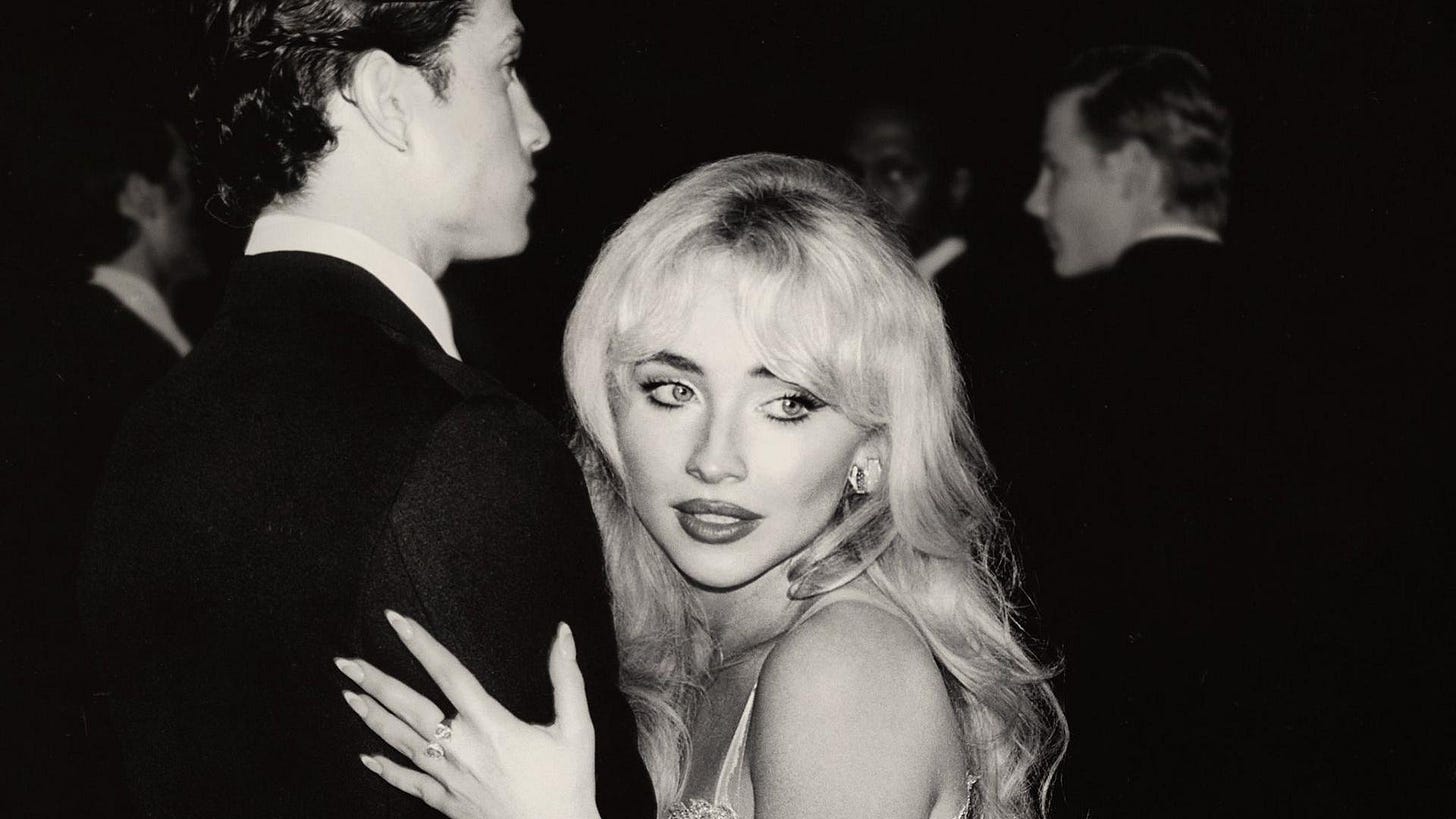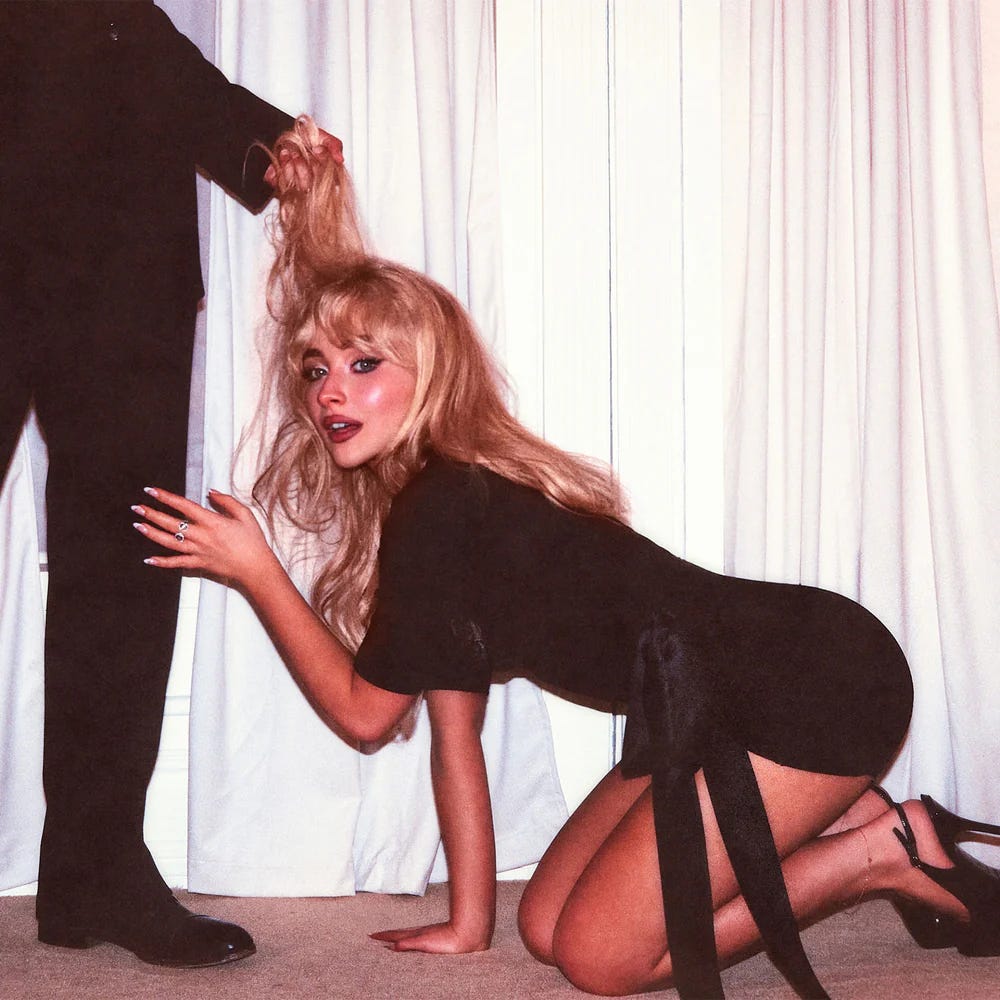The Uncanny Valley of Digital Pop Culture Discourse
What the response to Sabrina Carpenter's album cover teaches us
A few days before Sabrina Carpenter shared her original album cover for Man’s Best Friend, I went to the National Museum of Women in the Arts to explore their “Uncanny” exhibit, which featured an array of creepy and surreal works by female artists. There were wax figures of women who at first glance looked real, as well as a series of uncanny masks with real human eyes. One particular memorable installation was a large slab that looked like it had been stretched from skin. Up close it looked waxy and strange: two disembodied mouths slightly open, a faint trail connecting them that reminded me of an umbilical cord. The mouths looked feminine, vaginal even. A sign near the art shouted “DO NOT TOUCH.”
The pieces unsettled me, as they were meant to. I didn’t use my phone to search for what others were saying about them. I walked through the museum taking in all the art and letting my feelings marinate, even if that meant I didn’t have all the answers right away.
I thought about this experience a few days later when I first saw Carpenter’s now famous album cover. In the image, we see Carpenter on all fours next to a man in a suit whose face is hidden from view. She reaches for his leg with one crisply manicured hand as he holds a tangle of her hair in his fist. Carpenter is not looking up at him. She is looking at the camera. It’s a grittier image than her last cover, where Carpenter gazes lovingly at the viewer, a bright red kiss on her bare shoulder. Man’s Best Friend feels more vulnerable. Carpenter is known for her playfully sensual style, but the cover here feels less sultry than pornographic, less about sexuality per se and more about submissiveness.
I hated it upon my first glance. I’d been reading Sophie Gilbert’s riveting book Girl on Girl and found it impossible to place the Carpenter’s image in a context that didn’t raise my hackles. Gilbert clearly maps how much of the early aughts were defined by sexism that took away women’s power while claiming to offer women more freedom. I’ve written before about how much I enjoyed the humor and joy in Short N’ Sweet and resented moving from an image of femininity I found fun to an image I found concerning. I’d seen versions of this picture dozens of times, in ads, fashion spreads, even other music videos. Neither the images themselves nor the discourse surrounding them ever seemed to push things in a better direction.
I found myself increasingly frustrated by the digital discourse too, even the takes I agreed with. Short form content, whether written or video, tends to focus on immediate emotional reactions and surface-level examinations of feminist concepts. There are no reliable forms of citation in digital discourse, which leads to a lot of takes from individual influencers, rather than generative conversations between and among experts. This creates a cultural climate where even the most discussed issues fade into mere background noise and the most interesting ideas get buried.
I’ve started to wonder if that’s the point—we can’t move forward if we’re constantly stuck in the same discourse cycles. So much pop culture analysis today is ill-defined, more interested in creating gotcha moments than having genuine conversations. This happened recently when some social media users complained that a 2024 image of Carpenter lying in the grass near a sprinkler, with some arguing that she was glamorizing pedophilia since the scene looked reminiscent of a scene from the 1997 film version of Lolita. Never mind that Carpenter is a 26-year-old woman and there is nothing in the image itself that suggests she is younger than her age. The way the picture might echo the 1997 film’s aesthetic is interesting, but the focus is on accusing rather than engaging in genuine analysis.
The problem isn’t limited to video content either. Today’s pop culture articles often offer the same breadcrumbs of analysis. In a recent article for The Guardian, a critic claims that Carpenter’s photo spread for Rolling Stone fits with trad wife zeitgeist of the current moment, “Carpenter in gingham lingerie, posing with a deer in the woods surrounded by flowers, makes the subtext literal: this is a male fantasy for men who do not like women’s independence, and she is owning it.”
Is a woman posing nude with flowers emblematic of the male gaze? Is it specifically “trad wife?” The constant reliance on pithy pop culture terms ends up flattening what could be a genuinely fascinating conversation about representations of femininity. It keeps us forever spinning our wheels, creating a climate where women’s rights are reduced to a fad.
One way to tackle the “just vibes” echo chamber is to start to take our “bad” feelings more seriously. In Garth Greenwell’s fascinating essay, “Taking Offense: Reading Through Bad Feeling” he explores how having a negative response to a piece of art isn’t necessarily a bad thing. The key is that we must deeply engage it:
An initial, untutored response to offense is simply to shut down our perceptual apparatus, to refuse to see the thing that has offended us. Which means, if the art we’re responding to is interesting art, we may be shutting ourselves off from a value that, were we to engage with it, we might see as balancing out the pain of offendedness—or even, if it’s really interesting art, a value that is bound up with offendedness, a value we can only arrive at through offendedness, that lies on the other side of it.
For Greenwell, the opportunity to dwell in bad feeling is a gift that allows us to not just understand a piece of art more deeply, but to understand ourselves. This is what I think is the necessary next step for feminist pop culture discourse as well: to go beyond the outrage machine so that we can genuinely grapple with culture.
Since her Man’s Best Friend controversy, Carpenter has released a few alternative covers, one in which she is dancing in a room full of men who are turned away from the camera, and another where she is lounging alone in a room filled with flowers.
In the end, the original image does strike me as most impactful. The softer images of femininity that Carpenter draws on in her alternative covers don’t make me angry like the first one did. They also don’t have the same bite. Our digital discourse is intent on cycling through an endless array of hot takes. By confronting our own feelings about the cultural objects that haunt us, we better respect female artists who are navigating the same imperfect world we are.







